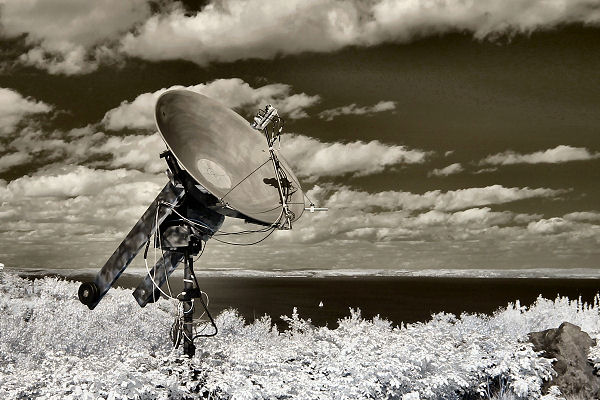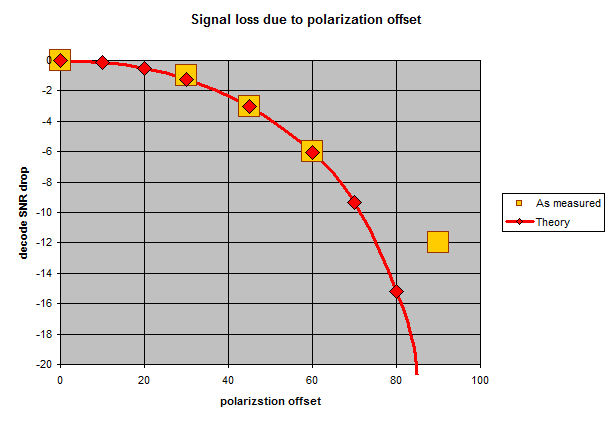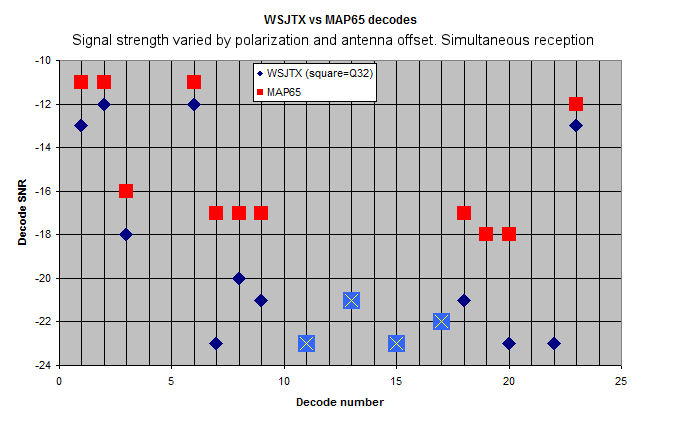DL0SHF - 10Ghz beacon SNR. A beginner's guide

1.2m prime focus dish + modified LNBF receiver with polarization rotation
The first test of a 10Ghz EME system on a real signal is often reception of the 10Ghz beacon, DL0SHF. You can read more about it here: DL0SHF_10GHZ_beacon.html. In order to make sense of the decode numbers you need to know about polarization rotation and possible differences in the SNR readout between WSJTX and MAP65 (often used with the FunCube SDR) and SNR dependency on some WSJTX settings. You also need to know how much power the beacon is running. Between repairs it's usually very stable, but the output power can change after repairs of the PA and driver amplifiers (which may occur once or twice a year).
Polarization Rotation
As the moon proceeds through the mutual window between DL0SHF (or any other station) and your station location the polarization offset will change. The is shown by the Dpol number in the astronomical window or WSJTX. The rotation is the result of the geometry between the two stations and the position of the moon. DL0SHF (and most other European based stations) transmit with fixed vertical polarization. Depending on the position of the moon and the receiving stations, the received polarization can anything from vertical to horizontal, i.e. and offset from 0 degrees to +/- 90 degrees. When using a small dish, you typically need all the signal you can get, so alignment of polarization is important. The plot below shows my measurement of the effect of a polarization offset on the DL0SHF signal. In theory, the loss factor is given by the square of the cosine of the offset angle.

The red diamond points and the red line show the theoretical loss, while the yellow squares show the measured loss. Up to about a 60 degree offset, theory and measurement agree quite well. Loss for a 10 degree offset of around 0.25dB, at 20 degrees this increases to about 0.6dB and at 30 degrees the loss is around 1.25 degrees. A 45 degree offset results in about a 3dB loss and a 60 degree offset gives you about a 6dB loss. In theory a 90 degree offset (cross polarization) would result in no signal at all (infinite loss), but in practice, probably due mostly to some polarization scattering by the signal reflection from the moon's surface, The actual loss is around 12dB.
Currently (8/23), using my 1.2m dish, DLOSHF with good polarization alignment decodes with an SNR of about -12dB with the moon at apogee (earlier this year, before a repair had to be made to the Tx, it was about 4 or 5dB stronger). This means that the cross polarized signal is right on the edge of a single period decode for my 1.2m dish. This shows the importance of being able to rotate polarization for stations which are geographically distant from DL0SHF (like stations in the North America). For stations in Europe polarization offset for DL0SHF is never much higher than about 15 degrees, and usually much less, so signal loss would be less than 0.3 degrees. In that case, polarization rotation is not really required.
The general convention is that US stations Tx and Rx using horizontal polarization, i.e. and offset of 90 degrees from that used by European stations. While this works for Rx of DL0SHF (and other EU stations) some of the time from some parts of the US, it can lead to significant signal loss at times. For stations in California, it works quite well much of the time. For stations in Maine it doesn't work well at all.
Rx Software and SNR reports
Note that SNR reports are rounded to the nearest dB before display, and therefore at times a real change of only 0.1dB (or even 0.01dB) in the computed SNR could change the displayed value by 1dB. In addition, SNR measurement on very weak signals are subject to some uncertainty. Keep this in mind when comparing SNR numbers.
DL0SHF uses Q65-60E, while most normal operation on 10Ghz uses Q65-60D. Decode strength, especially for DL0SHF can depend on what software you are using to decode the signal and just how your radio is setup. Most people will be using WSJTX 2.7.0 or newer or MAP65 v3.0.1 or newer. I have found a significant difference in the SNR reported by WSJTX and MAP65 as shown in the plot below:

Just for the record, my 10Ghz system uses a modified LNFB with a GPS locked LO reference and an IF of 432MHz. For WSJTX I use an Icon IC-7100 with Doppler tracking in 1Hz steps. For MAP65 I use a FunCube SDR, also Doppler tracking in 1Hz steps. The incoming signal is equally split between the two systems, so I can receive and decode a signal simultaneously with WSJTX and MAP65.
With relatively strong signals, I see MAP65 reporting an SNR which is about 1dB stronger then that reported by WSJTX. When I see -12 with WSJTX, I'd typically see -11 with MAP65. As signal strength is reduced (e.g. by changing polarization offset or antenna aiming offset), WSJTX shows a greater drop SNR, and I believe this is a fairly accurate measurement. MAP65 decodes SNR is always higher, and at the sensitivity limit may be 5 or 6dB higher. HOWEVER, both systems show very similar decode thresholds. At the limit of just being able to get a single period decode, that same signal decodes at around -23dB in WSJTX and -18dB in MAP65. This is not MAP65 acting as a "better" or more sensitive decoder. It's just a matter of internal calibration in the software.
Note that both system can equally well decode the same very weak signal. However MAP65 tells you it's maybe 5 or 6dB stronger than WSJTX does.
The advantage of WSJTX is that it can average signals, so, in the above plot at decode numbers 11, 13, 15 and 17, a Q32 decode was reported by WSJTX (average of two transmissions), while MAP65 recorded no decodes during this period. The conditions used to produce the weak signal were the polarization was offset by about 90 degrees and the antenna was effect by 0.5 degrees). The signals under these conditions were too weak for a single period decode.
So if you are comparing SNR reports with another station, and one station is using WSJTX and the other is using MAP65, you may get confused. You might ask why anyone would use MAP65 and there are two reasons. First it can show you 90kHz of the band, so you can look for signals outside the limited 3kHz range of WSJTX. Second, MAP65 can easily interface with a FunCube SDR and can then be easily tunes to a non-ham band frequency like 618MHz. 618MHz if the IF frequency generated by an unmodified FNFB receiver when looking at 10368MHz.
WSJTX configuration and Decode SNR values for DL0SHF
Note additionally that the SNR reported by WSJTX can depend on your receiver passband shape and frequency limits and where you put the DL0SHF sync tone. WSJTX needs a flat passband that's as wide as possible. The best way to get this is by using a reference spectrum for the Wide Graph. WSJTX does have a flattening algorithm which runs when a reference spectrum is not used, but it's not as good. NEVER use any type of DSP on the audio (like Noise Reduction). The only exception here is that a DSP noise blanker may be OK if you really need it (very rare on 10Ghz!).
If you put the sync tone of DL0SHF at too low a frequency, the SNR report may be incorrect. Usually it will be better than the true value, though under some conditions with certain audio distortions, it could be worse. Anything under 700Hz is very likely to give unreliable results. It's better to keep it up at around 1000Hz assuming your receiver passband extends up to 1000+1729+(spreading/2)Hz. Typically that would be around 2850Hz. If you have a narrower passband, you are probably OK moving the sync tone down to about 800Hz. WSJTX needs a bit of room above and below the actual signal so that it can get a measurement of just noise. With the sync tone at 700Hz, WSJTX reported decodes that were 1dB stronger than with the sync tone in the 800-100Hz region) when I was using a reference spectrum to flatten the audio (USB audio from IC-7100). When I checked the "flatten" checkbox instead of the reference spectrum, at 700Hz the decode strength changes from -11 to -16dB. With the sync tone at 1000Hz I got a decode strength of -12dB with either (or neither) checkbox checked. For more on Widegraph optimization and audio spectrum flattening, see https://bobatkins.com/radio/wsjtx_wide_graph.html
SUMMARY
For the most accurate decode SNR on DL0SHF, try the following:
- Use WSJTX rather than MAP65
- Turn off any DSP functions (especially "Noise Reduction")
- Turn off AGC (probably not needed for WSJTX decoding, but a good idea anyway for any noise measurements)
- Use a reference spectrum to flatten the audio spectrum for WSJTX
- Use the widest audio bandwidth setting on your radio if there is a choice. 2800Hz or more is desirable
- Use a sync tone frequency of 1000Hz if you have enough audio bandwidth. Don't go below 800Hz.
.jpg)